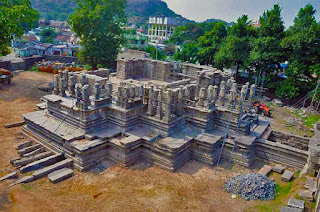 |
| Sri Rudreshwara Swamy Temple Telangana . sanskritimagazine.com |
The 1000-pillar temple with a ceremonial covered pavilion and three sanctums dedicated to Gods Shiva, Vishnu and Surya in Hanamkonda near Warangal is a fine example of Kakatiya architecture built by Kakatiya ruler Rudradeva in 1163 AD. It took 72 long years to build this temple using black granite and dolomitic rock.
 |
| Sri Rudreshwara Swamy Temple Telanganasanskritimagazine.com . |
Like many Hindu temples in the 14th century and later period were invaded by Muslim army from Delhi headed by rulers of Turkish origin. the 1000 pillar temple was also raided centuries back. The purpose of invasion and looting of rich Hindu temples was primarily to run the kingdom and to save money for future war expeditions so that the area of reign could be expanded farther and more revenue could be generated by way of tributes from small rulers, etc.
The 1000-pillar temple, also known as Rudrappa temple, was invaded by the army of the Delhi Sultanate ruled by Ghiyath al-Din Tughluq of Turkish origin. In 1323, he despatched a powerful army led by his son Ulugh Khan (later Muhammad bin Tughluq) to the Kakatiya capital Warangal, because the Kakatiya ruler Prataparudra refused to make tribute payments. First raid having been failed within four months he raided Warangal and other areas. (The same Ulugh Khan’s army invaded Srirangam in Tamil Nadu in 1323 and plundered the Perumal temple and its treasures. In the process the demonical army beheaded 12000 Sri Vaishnavas assembled at the temple to save the idols. The Kovil Olugu refers to this incident as “Pannirayiramtirumudi-tiruttina-kalabham” (the invasion which took 12000 heads;. https://www.opindia.com/2020/08/sacking-of-srirangam-how-delhi-sultanate-ravaged-one-of-vaishnavism-holiest-sites/)
 |
| Sri Rudreshwara Swamy Temple Telangana .wikiwand.com/ |
 |
| Thousand Pillar Temple in Hanamakondaoutlookindia.com |
The 1000 pillar temple is restored in 2021 and according to an Archaeological Survey of India (ASI) official Nandi is set to get a new leg and presently a gypsum is created till the broken leg of the stone bull is replaced with a black granite leg.
The Kakatiya Nandi, unlike their elephant, is an attempt at natural delineation; it shows even the veins on the snout. The hump of the Hanamkonda bull seems to be unnatural though his jewellery was well done. Basavesvara, who gave a fillip to Veerashaivism (he was not the founder), was supposed to be an avatar of Nandishwara and after his advent, Nandis were made in big sizes. I presume the Hanamkonda Nandi was one such.”
Millions of devotees and visitors who throng the temple daily want to see the nandi with areplaced legUNESCO conferred the World Heritage inscription to the historic Rudreshwar Temple, also known as the Ramappa Temple at Palampet in Mulugu district of Telangana, August 05, 2021.










.jfif)
